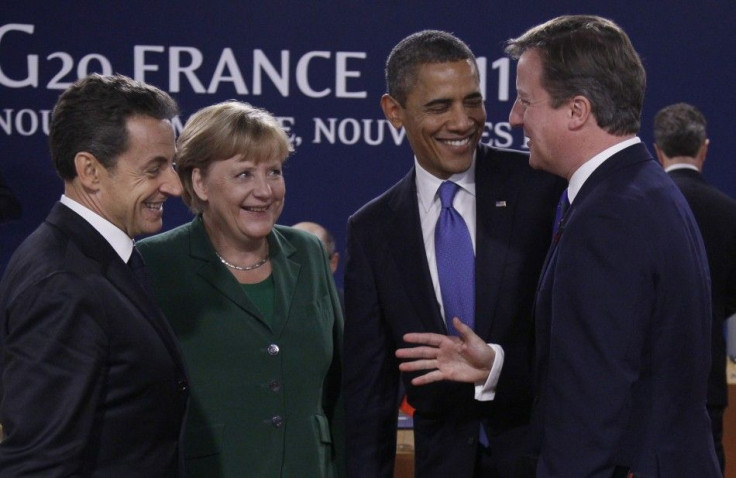2012 Outlook - How Will G20 Nations Fare?
Column

The year 2011 was the year of the protestor. What will 2012 bring?
Here's a preview of several likely developments in 2012. (We'll leave the larger, eschatological analyses to others, and focus on the economic / political.)
Econommic/political predictions/forecasts are fraught with margins of error, due to the many variables involved in a given metric -- and anyone who suggests otherwise is being disingenuous. Gross domestic product (GDP) is a good example: a nation's 2012 GDP could be at one level, if no unexpected events occur. Enter a credit crunch and that GDP will be considerably less.
Hence, the forecasts below assume an average monthly oil price of about $90 per barrel, and no third wave of the global financial crisis stemming from Europe. (Lehman Brothers and Greece were the first two waves.)
More than likely, the euro will still be in existence at the end of 2012. Europe's fortunate economies, primarily Germany and France, will find a way, aided by the International Monetary Fund and the European Central Bank, to muddle through regarding the costs associated with austerity plans for Italy and Greece.
They'll likely elongate the repayment plan for debt, to buy time, hoping that stronger growth in 2013 and beyond will make it easier for debt-laden countries to service and pay-down their debts.
Russia's power and influence on the international stage will continue to increase. Prime Minister Vladimir Putin, running for the presidency for a second time, will face a stronger opposition in 2012, but that will not blot-out Russia's arc to greater influence, largely stemming from its improving and diversifying economy. (Russia's 2010 GDP: $1.65 trillion.)
The days of American unilateralism ended with the Bush '43' Presidency, and look for Putin et al to continue to press for foreign policy solutions that all of the world's major powers view as in their interest, and against foreign policy interests based solely on U.S. interests.
China will finally decide to let its currency, the yuan, appreciate faster. A combination of too-high domestic inflation and international pressure will convince the rapid-growing economic powerhouse to adopt a more market-based approach to currency valuation.
Don't expect a miracle, but look for the yuan, presently valued at about 6.3 yuan to the U.S. dollar, to appreciate more than 4.7 percent gain it registered in 2011. The larger appreciation will help address one, major imbalance in the global economy.
Brazil, 203.5 million-strong and growing, with a $2.1 trillion economy (2010), will continue to impress institutional investors, economists, and its citizens, alike. The nation's large and well-developed agriculture, mining, manufacturing, and service sectors with an expanding middle class are indicative of an increasingly diverse economy better-able to withstand financial/economic shocks from abroad.
Consider: Brazil is now a net creditor, not net debtor, nation. Its expanding middle class helped the nation become one of the first to return to growth in 2010 after just two quarters of recession in 2009. The nation's GDP should increase 4-4.5 percent in 2012 and 4.5-5 percent in 2013, after a likely 7.5 percent growth rate in 2011. To be sure, 2012 represents a slowdown, but it's still furlongs ahead of the U.S. and European Union and will be one reason the global economy avoids a recession. Inflation, likely to total 4.5-5 percent in 2012, remains a concern, but so long as the nation's growth rate accelerates in 2013, Brazilians will tolerate it.
India, 1.2 billion people strong, will be another GDP star in 2012, with a 7.5-8 percent growth rate, after a likely near 10 percent growth rate in 2011. Economic liberalization, including stock ownership by inidviudual foreign investors, industrial deregulation, privatization of state-owned enterprises will continue to yield jobs. Further, India's large English-speaking workforce will enable it to maintain its comparative advantage in information technology and software personnel. Inflation is likely to remain high -- at/near 8 percent in 2012 -- and that remains one of the nation's major challenges, along with building-out its infrastructure; overall, strong domestic demand will keep India in the emerging market star category in 2012, and in the immediate years ahead.
Finally, the U.S. economic recovery will exceed economists'/analysts' forecasts. The world's largest economy could grow at a 2.8 percent rate, or faster, provided Europe's credit markets don't collapse.
All the signs are there for an acceleration in U.S. GDP growth in 2012 -- lower jobless claims, an expanding manufacturing sector, adequate auto sales, cash-flush corporations, modest pent-up consumer demand, a housing sector that appears to be bottoming, and rising consumer confidence.
Now, if job growth can accelerate modestly in the next 12 months, 2012 could end up being a refreshingly good year for the U.S. in terms of earnings growth, stock prices, and employment.
--
And a Happy New Year -- 2012 -- to all.
--
© Copyright IBTimes 2024. All rights reserved.





















